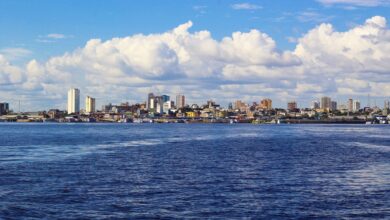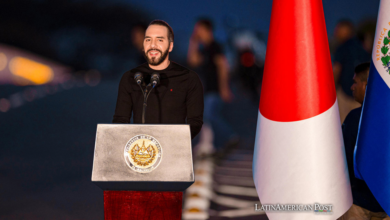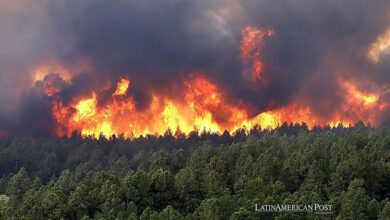The Line: The Futuristic City “Enclosed in a Wall” and Free of Emissions in Saudi Arabia
This Futuristic City, Which will be More than 150 Kilometers Long, 200 Meters Wide and 500 Meters High, has Caused Controversy for Displacing Thousands of People and Being an "Offense" to Environmental Causes.

Photo: NOS
LatinAmerican Post | Christopher Ramírez
Escucha este artículo
Leer en español: The Line: la ciudad futurista “encerrada en un muro” y libre de emisiones en Arabia Saudita
It is no secret to anyone that the Arabian peninsula is one of the richest territories in the world, thanks to the incredible amount of oil deposits that exist in this area of the Middle East.
According to a statistical report by World Energy BP, of the 14 countries that control 93.5% of the world's proven oil reserves, three are located in this area: Saudi Arabia with 298 billion barrels, Kuwait with 102 billion and the United Arab Emirates with 98 billion.
This privileged situation has made this type of nation begin to take the lead in the development of large architectural projects that dazzle with their beauty and "supernatural" characteristics. An example of this is Dubai, one of the seven emirates that make up the United Arab Emirates, which has the Burj Khalifa, a 828-meter-tall building that is considered the tallest in the world.
The futuristic and intelligent city of dreams
Faced with this reality, Saudi Arabia, being the country with the two most inhabited cities on the peninsula: Riyadh, with 7.5 million inhabitants, followed by Jeddah, with 4.7 million, has been developing, for more than 5 years, a revolutionary idea that would completely change the image of the city that people have today.
In 2017, the Saudi royals announced a new mega-country project called NEOM, which will cost more than 500 billion dollars and whose star city will be The Line: a city 200 meters wide, 500 meters high and 150 kilometers long, which will make it look like a glass wall full of innovation and technology.
The idea, as the crown prince of Saudi Arabia, Mohammed bin Salman, has explained on several occasions, is to create a smart city like never before seen on the planet, complying, of course, with the four items that govern this type of city and explained by the Inter-American Development Bank (IDB):
1. Sustainability: Just to give one example, Bin Salman has detailed that the city will be car-free and road-free, making mobility within The Line 100% sustainable and public.
"The designs unveiled today for the city's vertically layered communities will challenge traditional flat, horizontal cities and create a blueprint for nature preservation and better human habitability. The Line will address the challenges humanity faces in urban life and will shed light on alternative ways of living," the crown prince said in a press release.
2. Inclusive: Following the line of mobility, the goal, as explained by the Saudi Government, is to have an "ultra-high-speed transit" that mobilizes people in record time, without the need to depend 100% on it to move within the city.
This, in the words of the project organizers, can be achieved through an urban design that has as its axis the establishment and creation of basic facilities such as schools and clinics less than five minutes from homes. “No trip is expected to last more than 20 minutes,” they added.
3. Generation of wealth: This item can be seen in the fact that this city is part of Saudi Vision 2030, a project with which it wants to create more than 380,000 jobs and, therefore, generate more than 180,000 billion Saudi riyals (48 billion dollars) in its Gross Domestic Product (GDP).
4. Designed for citizens: It is logical that compliance with the three previous points shows that the city seeks, precisely, that the more than a million people who live in The Line radically change their lives, placing human and social development, above the economic one.
You may also like: The hidden face of renewable energies that affects Latin America
Do you really think about the citizens?
However, what seems like a "fairy tale" also has a history of discrimination behind it. From the moment it became known that The Line would go from being a simple dream to a viable project and a future reality, thousands of Saudi residents have demonstrated against the Government, alleging that the territory on which the city would be built is inhabited today by the Huwaitat tribe, as reported by the British newspaper The Guardian.
In total, more than 20,000 people would have to leave their homes to build The Line. This situation of non-conformity has unleashed a wave of repression against the Huwaitat, with at least 15 of the protesters kidnapped and imprisoned, according to the Qatari media Al Jazeera. For its part, the security of the Saudi State also confirmed that Abdul Rahim al-Huwaiti, a leader of this tribe, was assassinated in 2020 after revealing in a video what was happening in his territory.
Now, apart from the criticism that Saudi Arabia has received for the repressions of a political sense, some positions have also been added, such as that of Eliyahu Keller, an architect and historian who works as coordinator of the studies of History and Theory of Architecture at the SCE Negev School of Architecture, who argue that The Line is nothing more than a monument to the Arab ego, that it is not thought in “constructive terms, but in terms of ideas”.
For this expert, it could be considered crazy to establish an ideal that in order to live better you have to build new cities instead of strengthening existing ones. “There is no need to start from scratch. The thinking that says that it is possible to build a new city from scratch is exactly what has led to the current situation (…) The effort to face the challenges of the climate crisis must focus on improving our existing cities, not on creating new ones”.




